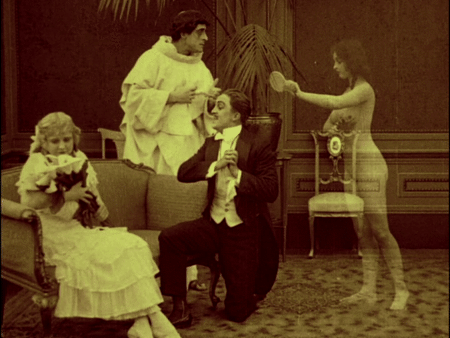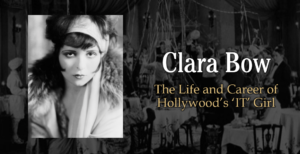
No era of filmmaking has the potential to shock and surprise you quite like the silent era. Numerous well-made, interesting silent films from around the world have waited over a century to be discovered by a larger audience. Some hidden silent gems are unearthed from the depths of the archive, restored and screened to audiences for the first time since the film’s initial release. Other silent films are rediscovered when a new version reaches streaming services or the festival circuit after years of being out of print. Others yet are found tucked away on a public domain YouTube channel that despite their rough quality and hastily concocted score somehow manages to capture your imagination.
In all of silent cinema, there has been no one as deserving of being rediscovered and lauded as Lois Weber. The most successful American female filmmaker of the silent period, Weber got her start making short films in the early 1910s alongside early pioneer Edwin S. Porter of The Great Train Robbery fame. She was one of several women who ran their own production studios in the late 1910s and early 20s only to slowly lose power and influence in the male-dominated studio era of the 1920s. Over the past decade, Lois Weber’s career has been revisited and praised, spurring in-depth biographies of her life and work alongside newly restored versions of her films released on home media and made available on streaming services.
As Weber’s reputation has been positively reevaluated, Weber’s most well-known films have become classics of silent cinema. Three of her films, Suspense (1913), Shoes (1916), and Where Are My Children? (1917), have been included on the National Film Registry as artistically and culturally significant films. Just like any other great director, Weber has numerous other fascinating and intriguing films that for some reason or other are not appreciated as much as they should be. Out of all of Weber’s work, my favorite hidden gem is Hypocrites (1915), her earliest complete surviving feature film that stands as a landmark achievement of 1910s feature films.
This article on Lois Weber’s 1915 film Hypocrites is part of the Classic Movie Blog Association‘s Hidden Classics Blogathon. For more wonderful hidden gems from other CMBA members visit the blogathon’s home page blogathon’s home page.
Hypocrites is essentially an early arthouse film, consisting of four vignettes all connected by the female embodiment of truth. The film first tells the story of a medieval ascetic monk Gabriel who is killed by the townspeople and religious leaders for sculpting truth as a naked woman. After this prologue, the film jumps to a modern 1910s congregation, employing the same actors from the medieval segment of the film to play similar parts. For example, Courtney Foote plays Gabriel the medieval monk and Gabriel the modern minister. Mrytle Styman plays a nun in the first segment and then a pious member of the congregation in the contemporary segment.
An autographed picture of Lois Weber as shown during Hypocrites‘ opening credits.
After preaching a sermon on hypocrisy that angers several of his congregants, the minister is captivated by a Parisian painting printed in the newspaper. The painting depicts truth personified as a naked woman similar to the monk’s sculpture shown earlier. While contemplating the meaning of this work of art, the minister falls into in a dream where he climbs a mountain to reach the dwelling of the female embodiment of truth. Several members of the congregation appear in his dream shown choosing money, family, or selfish pursuits over joining Gabriel’s quest for truth. Upon reaching the gate of truth, Gabriel follows Truth herself to expose the hypocrisy of his congregation, and later himself, to us the audience. The film ends as the congregation finds their minister dead in the chapel, shocked and disgusted to find him in possession of a lewd Sunday newspaper with a painting of naked Truth.
Weber got the idea for Hypocrites from Adolphe Faugeron’s 1914 painting La Vérité (The Truth) which features truth, personified as a naked woman, holding a mirror to a crowd. The crowd, representing society, recoils at the reflection, unwilling or unable to accept the truth and the true image of themselves in the mirror. Weber used Faugeron’s naked female embodiment of truth and her exposé of society’s hypocrisy as the lynchpin of Hypocrites. Borrowing Faugeron’s vision of truth, Weber films Margaret Edwards nude in the role of Truth, a decision that led to several prominent city censorship boards across the United States cutting or banning her film.
Gabriel the minister views a reproduction of Faugeron’s painting in the Sunday Newspaper.
Hypocrites‘ connection to art ran deeper than just a single painting. In a time when feature films remained largely trendy, cheap entertainment, Weber sought to elevate filmmaking to a work of serious art worthy of praise and critique. When describing the artistic merits of Hypocrites, Weber told the Los Angeles Herald:
From the day that I saw the reproduction of Faugeron’s painting, The Naked Truth [sic], I regretted my inability to teach on the screen the lesson I saw in his painting….Every obstacle we had been taught to avoid in pictures confronted me in the execution of this idea—the introduction of religious subjects, the different and many times double exposures requiring experimentation that would cost time and money, the necessity for an enormous cast, and last but not least, the introduction of the figure of ‘Truth’ in the only guise I could consider if I were to be as honest as Faugeron.
Lois Weber, 3 Apr 1915 Los Angeles Herald
Hypocrites was Weber’s attempt to translate Faugeron’s painting and art itself onto the silver screen. In creating filmed art, Weber constructed new and modified existing forms of cinematic storytelling. Hypocrites is a classic in large part because of Weber’s willingness to challenge existing modes of artistic representation on film and build her own unique aesthetic.
For example, when Weber’s contemporaries were shortening the length of each individual shot and frequently cross-cutting between scenes, Hypocrites featured several minute-plus long shots. Weber herself was well capable of cross-cutting as she showed in her fast-paced home invasion short Suspense two years earlier; however, she opted to slow down Hypocrites to reach her artistic goal.
In one shot lasting over two minutes, Weber tracks over the crowd that has come to see the unveiling of the monk’s sculpture. The camera floats from one group of people to another, showing each individual’s facial expressions and costumes. This tracking shot allows the audience to for a moment live with these characters, learning each group’s standing in society and their own vanity and pride. When the crowd erupts in anger once Gabriel’s nude sculpture is unveiled, this previous tracking shot has already provided the audience with the motivations behind the crowd’s actions. No title cards could replace the vast amount of information this two-minute tracking shot provides the audience.
Weber uses double exposure to show Gabriel the minister transform into Gabriel the monk in dreamlike fashion.
Alongside longer, fluid shots, Weber masterfully employs double exposure throughout the film, frequently transitioning between two shots, using fades instead of harsh cuts. When Gabriel enters his dream, Weber imposes Gabriel the monk atop the sleeping Gabriel the minister as the background of the first shot fades to black. This use of double exposure further connects the medieval and contemporary stories, alerting the viewer to the allegorical aspirations of the film and transporting us from reality to the dream world.
Weber’s use of double exposure is crucial in her depiction of truth who is only seen throughout the film in double-exposure shots. This use of double exposure helps to obfuscate Edward’s nudity and marks her apart from the other human characters in the film. When Truth shines her mirror to expose people’s hypocrisy, Weber employs several complicated techniques to transition between shots. The background pulls out of focus while Truth remains in focus before the foreground and background fade to a shot of the mirror’s reflection.
Truth holds her mirror of truth to reveal the hypocrisy of a young suitor.
Weber’s innovative use of tracking shots and double exposure is equally matched by Hypocrites‘ fluid yet engrossing story that cements the film’s impact on its audience. Whether it is the head abbot leading a murderous mob, a choir member reading a newspaper during church, or a rich member of the congregation taking umbrage with a sermon on hypocrisy, Hypocrites never flinches in criticizing religious hypocrisy amongst churchgoers and church leaders alike. Even our protagonist Gabriel is not beneath criticism as Truth shows him his own weakness and selfishness. Weber wasn’t interested in simply extolling the virtues of religion or offering simple solutions. Hypocrites invites viewers to be uncomfortable and retrospectively search their own souls for traces of hypocrisy.
While Hypocrites‘ distrust and skepticism of society’s various authority figures feel especially modern, other aspects of the film do not fit in with modern sensibilities. Truth’s rebuke of a group of young people partying at the beach in swimwear is especially trivial. Gabriel’s theatrical, histrionic acting, filled with sweeping hand gestures and overdramatic facial expressions, will be offputting to those not well acquainted with the diversity of silent-era acting styles. While these dated aspects of Hypocrites might cause a chuckle from the audience here or there, its earnest approach and dramatic acting help to build the film’s allegorical themes and supernatural dreamlike atmosphere.
Truth shows Gabriel the mote in his own eye.
Overall, Hypocrites is nothing short of the arrival of an auteur, showcasing some of Weber’s most impressive and complicated camerawork filled with stunning tracking shots and beautiful use of double exposures. Weber’s biting social criticism, which she would become known for over her career, never holds back on its criticism of the sacrosanct institution of early 20th-century American Christianity. The lack of a highly structured narrative, an unusual occurrence in Weber’s filmography, further allows Weber to experiment with the visual look of her film and break several norms of 1910s filmmaking.
Simply put, Hypocrites is a hidden classic that deserves to be seen not just as one of Lois Weber’s best artistic achievements but as one of the most ambitious and impressive works of American silent cinema.
Photo Gallery





















Great stuff! Love Lois Weber.